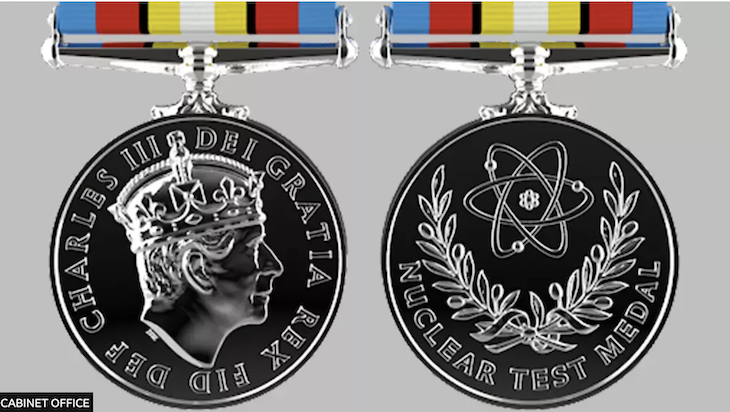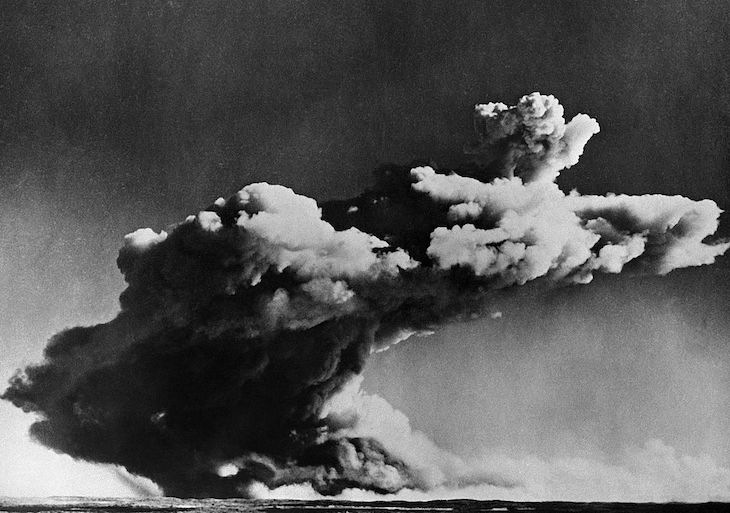Some wars get forgotten (viz Korea and Malaya); others are constantly refreshed in memory. As the manager of an Asian investment trust in the late 1980s, some 44 years after the Second World War, I was asked by my board to cough up a large sum of money to fund a statue of Field Marshal, Viscount Slim, the general who led British forces in India and Burma.
This was indeed a huge error of omission. Slim had won arguably the greatest victories of British forces in the Second World War: the Battle of Imphal in India and the Battle of Irrawaddy River in Burma. His splendidly executed statue was duly unveiled in 1993 and sits proudly in Whitehall. Even later, despite a somewhat less obvious case of omission, following a novel Animals in War [1984] by Jilly Cooper, a memorial of the same name was erected in front of Hyde Park’s Brook gate in 2004.
‘I saw right through my hands as the light was so intense. It felt like my blood was boiling.’
Another way of remembering the past is the creation of a new medal. In 2014, some 67 years after the end of the Second World War, the Arctic Star was invented to reward those naval officers and merchant seamen who served on the convoys that took tanks, spitfires and munitions to the Russians in Archangel and Murmansk.
On Friday, another new medal was unveiled by the Cabinet Office. The medal features an engraving of an atom surrounded by olive branches. The ‘Nuclear Test Medal’, as it has been inscribed on one side with a portrait of King Charles on the other, could best be described as a Cold War decoration. Last year, Prime Minister Rishi Sunak announced the post-hoc award when he attended the first-ever ceremony for nuclear veterans at the National Memorial Arboretum. He affirmed that
‘Their commitment and service has preserved peace for the past 70 years, and it is only right their contribution to our safety, freedom and way of life is appropriately recognised with this honour.‘
It marked the 70th anniversary of the UK’s first test of a British nuclear weapon, a plutonium implosion device. The nuclear test, which took place on the Montebello Islands of Western Australia on 3 October 1952, made Britain the third nuclear power after the United States and the Soviet Union. It is planned that the British ‘nuke award’ will be presented to remaining veterans out of some 20,000 British and 16,000 Australians troops and civilians, who worked on nuclear test programs which lasted from 1952 to 1967.

Britain’s contribution to the development of nuclear weapons is somewhat overlooked. As veterans minister, Johnny Mercer MP, has commented, ‘it’s important to remember the contributions of the veterans, scientists and staff who worked on Britain’s nuclear programme.’ As is often the case with Hollywood films, the recently released Oppenheimer, a biopic of the scientist who led the development of the atom bomb at Los Alamos, incorrectly implies that the atom bomb was wholly American in origin. It was not.
After all, it was Ernest Rutherford who split the atom at Manchester University in 1917. Subsequently, the critical scientific breakthrough in the development of the atom bomb was made at Birmingham university in 1939. It was there that two German Jewish refugee scientists, Otto Frisch and Rudolph Peierls, drafted a memorandum with a mathematical calculation showing that just a kilo of uranium-235, whose isotope could be separated from uranium-238, would be all that was needed to build a nuclear bomb. It was a revelation that suddenly made a deliverable weapon possible. Within months the MAUD Committee (Military Application of Uranium Detonation) set up a project to develop a nuclear bomb under the codename Tube Alloys. At this point even Japan, under the direction of Dr. Yohio Nishima, who had worked under legendary physicist Niels Bohr in Denmark, was ahead of the US in terms of its nuclear weapons program. To help the US catch up Tube Alloys was rolled into the Manhattan Project.
Given the UK’s part in the development of a nuclear deterrent, weapons that largely contributed to preventing the superpower Cold War from morphing into a ‘hot war’, why is it only now that a ‘nuke medal’ is being struck? The timing may in part be related to the lengthy campaign by veterans to be compensated for their exposure to radioactive fallout from British nuclear tests. As former conscript John Morris, who was stationed on Christmas Island, noted ‘I saw right through my hands as the light was so intense. It felt like my blood was boiling. The palm trees – which had been 20 miles away – were scorched.’ Supposedly Morris demanded of Boris Johnson when he was prime minister, ‘Give me a medal or tell me to sod off.’
Two issues of controversy have developed over the years when it comes to the nuclear tests. Was the health of the ‘nuke’ soldiers impaired by their exposure to nuclear radiation? And were soldiers, who were often lined up on the beaches opposite the detonation site, deliberately exposed to nuclear radiation? The government’s response is unequivocal,
‘The MOD does not accept that participants at the UK atmospheric nuclear test and weapons experiments were, as a result, exposed to ionising radiation that adversely affected their health.’
It is argued by government scientists that soldiers serving on Christmas Island received just 35 per cent of the background radiation doses that they would have had in the UK.
Yet claims that exposure caused cancers, infertility and other conditions are persistent. By contrast with the UK, the US government has accepted a much larger degree of responsibility. American nuclear veterans are entitled to $75,000 (£60,00) in compensation for 20 cancers known to be caused by radiation exposure. The problem for UK veterans is that, from a legal viewpoint, conclusive proof of cause and effect is virtually impossible.
The same legal problems apply to the second question of the deliberate exposure of soldiers to radiation. Not only were investigating teams sent to Hiroshima, but extensive research on radiological warfare was carried out post-war by such eminent scientists as Otto Frisch, Alan Nunn May (who was later imprisoned for passing nuclear secrets to the Soviet Union), James Chadwick and Sir John Cockcroft. Over many years, experimental research was carried out at Porton Down and the Cavendish Laboratory in Cambridge. British scientists were clearly aware of the health risks of nuclear radiation exposure.
But even if the effects of radiation sickness were known in the UK as now seems clear, whether the British armed forces were fully informed of the risks is uncertain. In 1945 a now deceased friend, Peter Daniel, who, after serving on the Arctic Convoys, deployed on the battleship HMS Duke of York to Kure in Japan, from where he travelled the short distance to Hiroshima. It was a photographic expedition to scope the nuclear devastation. Daniel’s commanding officer, who authorised the trip, was clearly oblivious to the health risks. (Peter Daniel incidentally lived to the ripe old age of 91 – in time to receive an Arctic Star medal). Quite simply, secrecy or bureaucratic incompetence may have prevented the warning of even high-ranking officers of the potential long term health risks of nuclear contamination during nuclear testing. Proving deliberate and knowing contamination of British troops and the health risks that were entailed by nuclear tests has been difficult to do so conclusively.
However, the fact that the ‘Nuclear Test Medal’ may be seen, particularly by left wing media, as simply a sop to campaigning British Army veterans should not detract from remembering the UK’s important role in the development of nuclear weapons both in the Second World War, as well as our role in Cold War nuclear deterrence. The defeat of totalitarian socialism, whose deleterious economic and social effects were seen in every post-war communist state, was essential to the prosperity that the West enjoys today. As a new cold war with Russia and China simmers, the Nuclear Test Medal is a timely reminder of Britain’s part in winning the last Cold War.






Comments